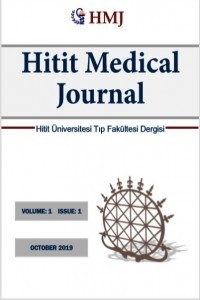Geriatrik yaş popülasyonunun ses performansının objektif ve subjektif olarak değerlendirilmesi
Objective and Subjective Analysis of Voice Performance In The Geriatric Population
___
- 1. Han D, Xu W, Hu R, Zhang L. Voice function following Han's uvulopalatopharyngoplasty. J Laryngol Otol 2012;126:47-51.
- 2. Dejonckere PH, Bradley P, Clemente P, et al; Committee on Phoniatrics of the European Laryngological Society (ELS). A basic protocol for functional assessment of voice pathology, especially for investigating the efficacy of (phonosurgical) treatments and evaluating new assessment techniques. Guideline elaborated by the Committee on Phoniatrics of the European Laryngological Society (ELS). Eur Arch Otorhinolaryngol 2001;258:77-82.
- 3. Hogikyan ND, Sethuraman G. Validation of an instrument to measure voice-related quality of life (V-RQOL). J Voice 1999;13:557-69.
- 4. Jacobson BH, Johnson A, Grywalski C, et al. The voice handicap index (VHI) development and validation. American Journal of Speech-Language Pathology 1997;6:66-70.
- 5. Baken RJ. The aged voice: a new hypothesis. J Voice 2005;19:317-25.
- 6. Koufman JA, Isaacson G. Voice disorders. The Otolaryngologic Clinics of North America 1991;24:1120-1.
- 7. Ward PH, Colton R, McConnell F, Malmgren L, Kashima H, Woodson G. Aging of the voice and swallowing. Otolaryngol Head Neck Surg 1989;100:283-6.
- 8. Atan D, Ozcan KM, Ikincioğulları A, Köseoğlu S, Çetin MA, Ensari S, et al. The effect of obstructive sleep apnea syndrome and continuous positive airway pressure treatment on voice performance. Sleep Breath 2015;19:777-82.
- 9. Ringel RL, Chodako-Zajko WJ. Vocal indices of biological age. Journal of Voice 1987;1:31-7.
- 10. Gregory ND, Chandran S, Lurie D, Sataloff RT. Voice disorders in the elderly. J Voice 2012;26:254-8.
- 11. Thomas G, Mathews SS, Chrysolyte SB, Rupa V. Outcome analysis of benign vocal cord lesions by videostroboscopy, acoustic analysis and voice handicap index. Indian J Otolaryngol Head Neck Surg 2007;59:336-40.
- 12. Hsiung MW, Pai L, Wang HW. Correlation between voice handicap index and voice laboratory measurements in dysphonic patients. Eur Arch Otorhinolaryngol 2002;259:97-9.
- 13. Wheeler KM, Collins SP, Sapienza CM. The relationship between VHI scores and specific acoustic measures of mildly disordered voice production. J Voice 2006;20:308-17.
- Yayın Aralığı: Yılda 3 Sayı
- Başlangıç: 2019
- Yayıncı: Hitit Üniversitesi
Elif SAGSAK, Ayşegül ZENCİROĞLU
Geriatrik yaş popülasyonunun ses performansının objektif ve subjektif olarak değerlendirilmesi
Kolon Adenokarsinomlarinda Kras Mutasyonlarinin Sikliği Ve Lenf Nodu Metastazi İle İlişkisi
Gökhan VARLI, İbrahim Hanifi ÖZERCAN, Ebru ÖNALAN
Nadir Bir Akut Karın Sebebi Yabancı Cisme Bağlı Perforasyon
Murathan ERKENT, İbrahim Tayfun ŞAHİNER, Murat KENDİRCİ, Ramazan TOPÇU, İsmail SEZİKLİ
KABG Sonrası Safen İnsizyon Yaralarının Primer ve Vakum Yardımlı Kapama Sonuçları
Utku ALEMDAROĞLU, Sertan ÖZYALÇIN, İzzet HAFEZ, Emin EROL, Adnan YALÇINKAYA, Hüseyin TÜNEL, Adem İlkay DİKEN
Cinsiyet Disforisinde Genetik Faktörlerin Rolü
Duygu ONUR CURA, Tufan ÇANKAYA, Ayfer ULGENALP
Epitelde Atipik Skuamöz Hücreler İçeren Eritema ab igne Olgusu
